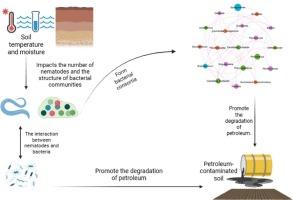温度和湿度对细菌和线虫共接种修复石油污染土壤的影响
IF 5
2区 农林科学
Q1 SOIL SCIENCE
引用次数: 0
摘要
石油污染对全球环境构成严重威胁。微生物具有降解石油的巨大潜力,并且对环境友好,但其效果因环境条件而异。线虫可以进一步提高除油效率,但它们与细菌联合修复的机制,特别是在应对环境变化方面的机制尚不清楚。为了解决这一知识缺口,本研究通过在三种温度和湿度水平下将线虫引入污染土壤,研究了温度和湿度对石油修复的影响。22°C和50%湿度的石油污染土壤作为基准处理(SPN),其变化规律为:较低温度(14°C, SPN_LT)、较高温度(30°C, SPN_HT)、较低湿度(40%,SPN_LM)和较高湿度(60%,SPN_HM)。168天后,结果表明,线虫通过改变细菌群落结构和细菌属之间的关系,在所有测试条件下始终促进石油降解。值得注意的是,SPN_HM和SPN_HT处理的原油含量显著降低,表明温度升高和水分增加都能提高原油的除油效率。Shannon指数随湿度升高而显著升高,随温度升高而降低。主坐标分析(PCoA)进一步表明,温度对细菌群落结构的影响大于湿度。这些发现表明,温度和湿度通过不同的机制促进油的修复。通过相关网络和共生网络分析,发现不同的石油降解菌属形成了独立的网络模块。这些模块包括降解菌和相关功能菌,它们之间存在显著的正相关关系,这表明烃类分解是由由降解菌和辅助功能菌组成的不同菌群驱动的。综上所述,我们的研究表明,增加湿度和温度,结合线虫的添加,可以显著提高石油的降解效率。这种改进归因于线虫和细菌之间的相互作用,突出了石油降解属及其功能伙伴的重要性。未来的研究应重点关注辅助功能菌和线虫在促进微生物降解中的作用。本文章由计算机程序翻译,如有差异,请以英文原文为准。

Effects of temperature and moisture on the co-inoculation remediation of petroleum-polluted soil by bacteria and nematodes
Petroleum contamination poses a serious global environment threat. Microorganisms have substantial potential for petroleum degradation and are environmentally friendly, but their effectiveness varies with environmental conditions. Nematodes can further enhance oil removal efficiency, but the mechanisms underlying their combined remediation with bacteria, particularly in response to environmental changes, remain unclear. To address this knowledge gap, this study investigated the effects of temperature and moisture on oil remediation by introducing nematodes into contaminated soil under three levels of temperature and moisture. Petroleum-contaminated soil at 22 °C and 50 % humidity served as the baseline treatment (SPN), with the following variations: lower temperature (14 °C, SPN_LT), higher temperature (30 °C, SPN_HT), lower moisture (40 %, SPN_LM), and higher moisture (60 %, SPN_HM). After 168 days, results indicated that nematodes consistently facilitated petroleum degradation across all tested conditions by modifying bacterial community structure and the relationships among bacterial genera. Notably, petroleum content was significantly lower in the SPN_HM and SPN_HT treatments, indicating that both elevated temperature and increased moisture enhance oil removal efficiency. Interestingly, the Shannon index increased significantly with rising moisture but decreased with increasing temperature. Principal coordinates analysis (PCoA) further indicated that temperature had a stronger influence on bacterial community structure than moisture. These findings suggest that temperature and moisture enhance oil remediation through distinct mechanisms. Furthermore, correlation and co-occurrence network analyses revealed that different petroleum-degrading bacterial genera formed separate network modules. These modules included both degradative and associated functional genera, with significant positive correlations, indicating that hydrocarbon breakdown is driven by diverse bacterial consortia composed of both degraders and supportive functional bacteria. In conclusion, our study demonstrates that increased moisture and temperature, combined with nematode addition, significantly improve petroleum degradation efficiency. This improvement is attributed to the interactions between nematodes and bacteria, highlighting the importance of both petroleum-degrading genera and their functional partners. Future research should focus on the roles of auxiliary functional bacteria and nematodes in promoting microbial biodegradation.
求助全文
通过发布文献求助,成功后即可免费获取论文全文。
去求助
来源期刊

Applied Soil Ecology
农林科学-土壤科学
CiteScore
9.70
自引率
4.20%
发文量
363
审稿时长
5.3 months
期刊介绍:
Applied Soil Ecology addresses the role of soil organisms and their interactions in relation to: sustainability and productivity, nutrient cycling and other soil processes, the maintenance of soil functions, the impact of human activities on soil ecosystems and bio(techno)logical control of soil-inhabiting pests, diseases and weeds.
 求助内容:
求助内容: 应助结果提醒方式:
应助结果提醒方式:


